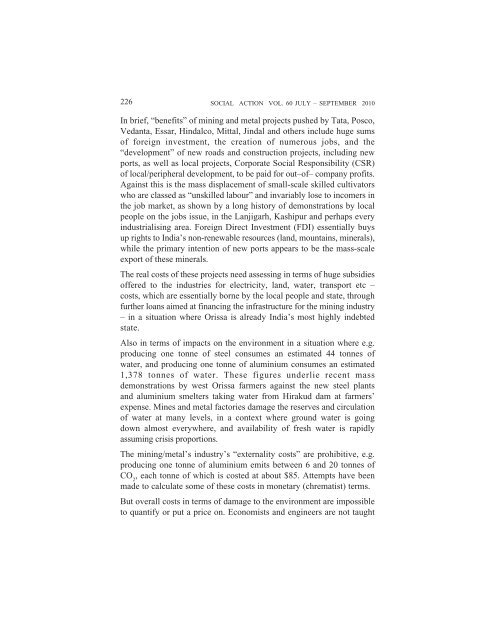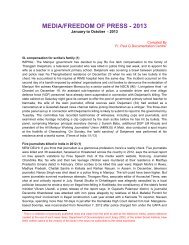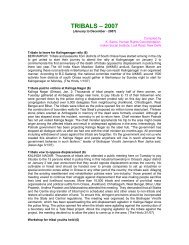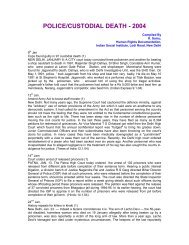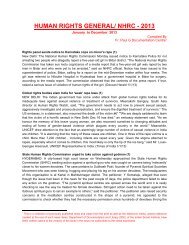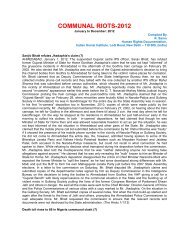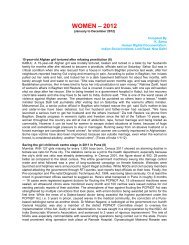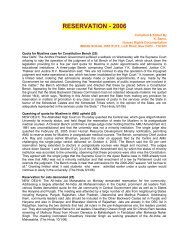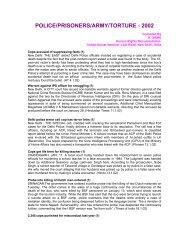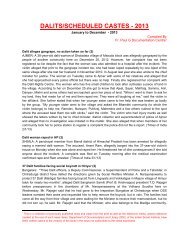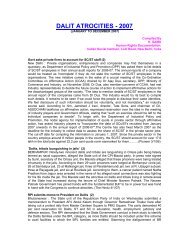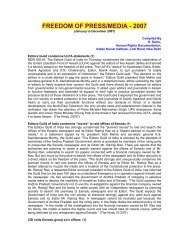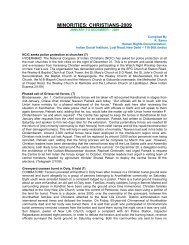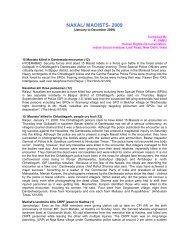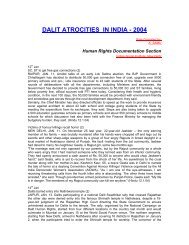Mining and Movements - Causes of Tribal Militancy - Indian Social ...
Mining and Movements - Causes of Tribal Militancy - Indian Social ...
Mining and Movements - Causes of Tribal Militancy - Indian Social ...
You also want an ePaper? Increase the reach of your titles
YUMPU automatically turns print PDFs into web optimized ePapers that Google loves.
226SOCIAL ACTION VOL. 60 JULY – SEPTEMBER 2010In brief, “benefits” <strong>of</strong> mining <strong>and</strong> metal projects pushed by Tata, Posco,Vedanta, Essar, Hindalco, Mittal, Jindal <strong>and</strong> others include huge sums<strong>of</strong> foreign investment, the creation <strong>of</strong> numerous jobs, <strong>and</strong> the“development” <strong>of</strong> new roads <strong>and</strong> construction projects, including newports, as well as local projects, Corporate <strong>Social</strong> Responsibility (CSR)<strong>of</strong> local/peripheral development, to be paid for out–<strong>of</strong>– company pr<strong>of</strong>its.Against this is the mass displacement <strong>of</strong> small-scale skilled cultivatorswho are classed as “unskilled labour” <strong>and</strong> invariably lose to incomers inthe job market, as shown by a long history <strong>of</strong> demonstrations by localpeople on the jobs issue, in the Lanjigarh, Kashipur <strong>and</strong> perhaps everyindustrialising area. Foreign Direct Investment (FDI) essentially buysup rights to India’s non-renewable resources (l<strong>and</strong>, mountains, minerals),while the primary intention <strong>of</strong> new ports appears to be the mass-scaleexport <strong>of</strong> these minerals.The real costs <strong>of</strong> these projects need assessing in terms <strong>of</strong> huge subsidies<strong>of</strong>fered to the industries for electricity, l<strong>and</strong>, water, transport etc –costs, which are essentially borne by the local people <strong>and</strong> state, throughfurther loans aimed at financing the infrastructure for the mining industry– in a situation where Orissa is already India’s most highly indebtedstate.Also in terms <strong>of</strong> impacts on the environment in a situation where e.g.producing one tonne <strong>of</strong> steel consumes an estimated 44 tonnes <strong>of</strong>water, <strong>and</strong> producing one tonne <strong>of</strong> aluminium consumes an estimated1,378 tonnes <strong>of</strong> water. These figures underlie recent massdemonstrations by west Orissa farmers against the new steel plants<strong>and</strong> aluminium smelters taking water from Hirakud dam at farmers’expense. Mines <strong>and</strong> metal factories damage the reserves <strong>and</strong> circulation<strong>of</strong> water at many levels, in a context where ground water is goingdown almost everywhere, <strong>and</strong> availability <strong>of</strong> fresh water is rapidlyassuming crisis proportions.The mining/metal’s industry’s “externality costs” are prohibitive, e.g.producing one tonne <strong>of</strong> aluminium emits between 6 <strong>and</strong> 20 tonnes <strong>of</strong>CO 2, each tonne <strong>of</strong> which is costed at about $85. Attempts have beenmade to calculate some <strong>of</strong> these costs in monetary (chrematist) terms.But overall costs in terms <strong>of</strong> damage to the environment are impossibleto quantify or put a price on. Economists <strong>and</strong> engineers are not taught


